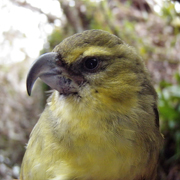|
MAUI PARROTBILL } Pseudonestor xanthophrys

|
RANGE: Maui
STATUS: This bird has been protected as Endangered under the U.S. Endangered Species Act since 1967.
THREATS: Habitat loss, climate change, disease
So much of the Maui parrotbill’s habitat has been so destroyed that today it can only be found in 19 square miles of mesic and wet forests at 3,900 – 7,100 feet on the windward slopes of Haleakala on the island of Maui. The total population of this finch in the honeycreeper family is estimated at just 500, making it critically endangered. It’s named for its distinctive, large beak, which it uses along with its powerful jaw muscles to remove bark and wood from small trees, eating the insects underneath, and to bite open fruits in search of insects. The parrotbill is susceptible to avian malaria, spread by mosquitoes — which can survive higher on mountaintops as global warming raises temperatures at high elevations. This pushes habitat upslope for endangered Hawaiian birds like the parrotbill, further jeopardizing their already reduced chance at survival.
|